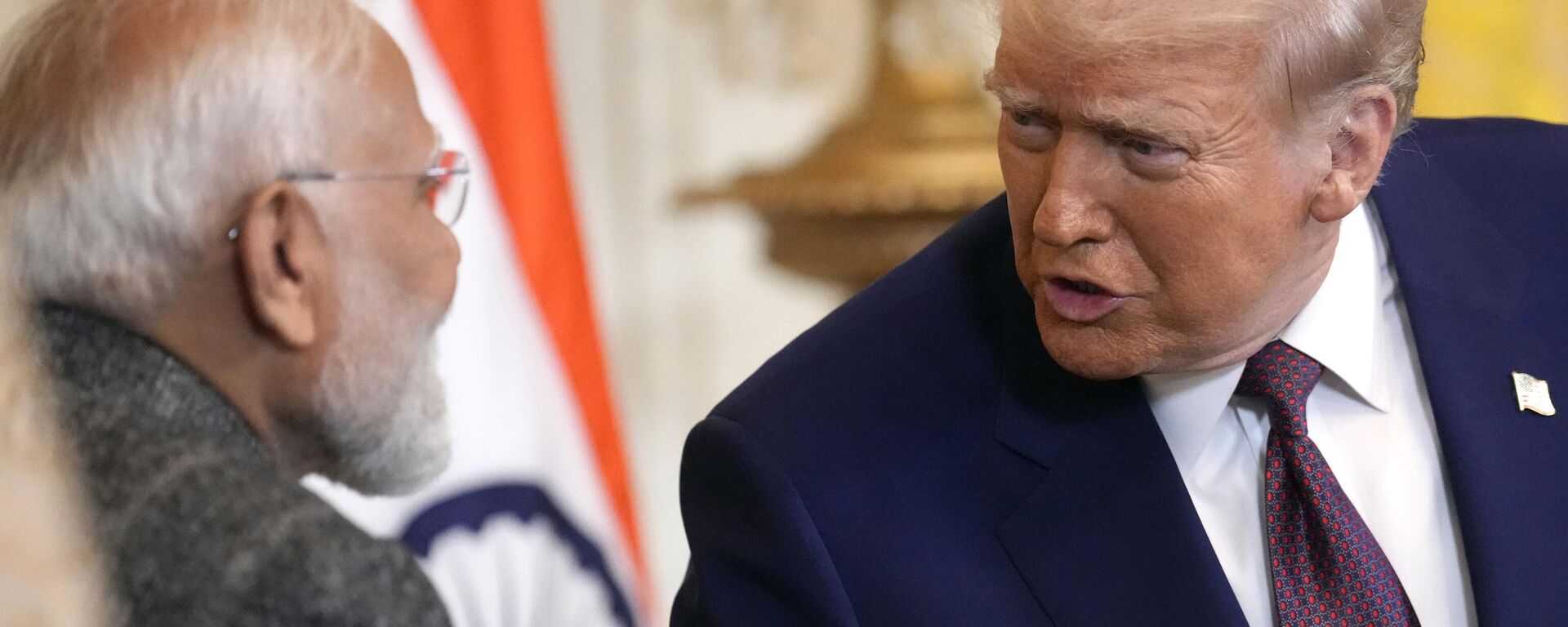https://sputniknews.in/20250804/-russian-weapons-success-in-op-sindoor-triggering-us-tariff-war-on-india-9542725.html
Russian Weapons Success in Op Sindoor Triggering US Tariff War on India?
Russian Weapons Success in Op Sindoor Triggering US Tariff War on India?
Sputnik India
The Indian Armed Forces rely heavily on Russian equipment, with the Army, Navy, and Air Force operating tanks, warships, fighter jets, and other weaponry of... 04.08.2025, Sputnik India
2025-08-04T21:00+0530
2025-08-04T21:00+0530
2025-08-05T06:31+0530
sputnik opinion
donald trump
india
russia
pakistan
indian air force (iaf)
ministry of defence (mod)
s-400 air defense systems
brahmos supersonic cruise missile
missiles
https://cdn1.img.sputniknews.in/img/07e9/02/13/8791259_0:0:3072:1728_1920x0_80_0_0_9f72aaefecc6e7141682ea411566582d.jpg
India's weapons platforms, including the Russian-origin S-400 anti-aircraft missile system and the Indo-Russian joint venture, BrahMos, played a key role in the recent counter-terror campaign against Pakistan, Operation Sindoor.While the S-400 earned acclaim from military pundits, the country's citizenry and the top leadership, including Prime Minister Narendra Modi, BrahMos left craters on Pakistani airfields, as well as destroyed the neighbouring nation's radar sites and left visible holes in their aircraft hangars, all pointing towards heavy damage at Pakistan's military installations.Interestingly, certain reports suggest that one of the targets of India's air strikes in Pakistan was the country's main base housing American F-16s. Moreover, assessments by some OSINT experts suggest that Pakistan lost approximately 6 fighter jets, including the F-16s, besides two of the Islamic Republic's Airborne Warning and Control System (AWACS) aircraft and a military transport plane.Last month, US President Donald Trump claimed that the India-Pakistan military confrontation in May this year resulted in the shooting down of five warplanes, without specifying which country lost what and how many.Of late, the US has launched a scathing and unrelenting attack on India, slamming it for continuing to buy weapons and oil from Russia.The US President noted that despite friendly relations, US-India trade remains limited due to India’s high tariffs and stringent trade barriers. He also highlighted India’s significant military and energy purchases from Russia.The US is clearly feeling uneasy, especially as India keeps prioritising combat-tested Russian hardware over American offerings, Gaurav Kumar, a defence researcher at United Service Institution of India (USI), the country's oldest military think tank, told Sputnik India. It partly explains why Trump administration has sharply criticised India's and Russia's economies, calling out India's defence purchases from Russia, and even pushing high tariffs of 25 %, he underlined.America's decision to announce tariffs on India is largely driven by Trump administration's motto of 'Make America Great Again (MAGA)', retired Lieutenant General Dushyant Singh, who currently serves as the Director General of the Centre for Land Warfare Studies (CLAWS), believes.Singh suggested that while the US wants to wean India away from Russia, the decision to impose harsh tariffs on Indian exports was part of the Trump administration's game plan to pressure India to open up its lucrative consumer market, the world's largest, to American companies, enabling US firms to earn billions.Furthermore, one must not forget that the US economy is in the doldrums at present, he said. The American economy is at its lowest, with the current growth rate of 1.5% and $36 trillion in debt, and so its leadership has to find some ways to resurrect it, the veteran added. But the Trump administration's efforts are not paying off, with the inflation rate hovering above 2.50% for the last few months, Singh pointed out.All this has led to a rise in the costs of several products, with the public at large facing the heat of the spike in prices.
https://sputniknews.in/20250804/white-house-accuses-india-of-financing-ukraine-conflict--9538252.html
india
russia
pakistan
delhi
new delhi
islamabad
washington d.c.
ukraine
moscow
kiev
gaza strip
israel
Sputnik India
feedback.hindi@sputniknews.com
+74956456601
MIA „Rossiya Segodnya“
2025
Pawan Atri
https://cdn1.img.sputniknews.in/img/07e6/0c/13/139630_147:0:831:684_100x100_80_0_0_8fa2b25903e7787fe6a2698552c167df.png
Pawan Atri
https://cdn1.img.sputniknews.in/img/07e6/0c/13/139630_147:0:831:684_100x100_80_0_0_8fa2b25903e7787fe6a2698552c167df.png
News
en_IN
Sputnik India
feedback.hindi@sputniknews.com
+74956456601
MIA „Rossiya Segodnya“
Sputnik India
feedback.hindi@sputniknews.com
+74956456601
MIA „Rossiya Segodnya“
Pawan Atri
https://cdn1.img.sputniknews.in/img/07e6/0c/13/139630_147:0:831:684_100x100_80_0_0_8fa2b25903e7787fe6a2698552c167df.png
donald trump, india, russia, pakistan, indian air force (iaf), ministry of defence (mod), s-400 air defense systems, brahmos supersonic cruise missile, missiles, delhi, new delhi, islamabad, operation sindoor, military equipment, washington d.c., white house, tariffs, ukraine, moscow, kiev, special military operation, houthis, gaza strip, israel, israel defense forces (idf) , hamas
donald trump, india, russia, pakistan, indian air force (iaf), ministry of defence (mod), s-400 air defense systems, brahmos supersonic cruise missile, missiles, delhi, new delhi, islamabad, operation sindoor, military equipment, washington d.c., white house, tariffs, ukraine, moscow, kiev, special military operation, houthis, gaza strip, israel, israel defense forces (idf) , hamas
Russian Weapons Success in Op Sindoor Triggering US Tariff War on India?
21:00 04.08.2025 (Updated: 06:31 05.08.2025) The Indian Armed Forces rely heavily on Russian equipment, with the Army, Navy, and Air Force operating tanks, warships, fighter jets, and other weaponry of Russian origin.
India's weapons platforms, including the Russian-origin S-400 anti-aircraft missile system and the Indo-Russian joint venture, BrahMos, played a key role in the recent counter-terror campaign against Pakistan, Operation Sindoor.
While the S-400 earned acclaim from military pundits, the country's citizenry and the top leadership, including Prime Minister
Narendra Modi, BrahMos left craters on Pakistani airfields, as well as destroyed the neighbouring nation's radar sites and
left visible holes in their aircraft hangars, all pointing towards heavy damage at Pakistan's military installations.
Interestingly, certain reports suggest that one of the targets of India's air strikes in Pakistan was the country's main base housing
American F-16s. Moreover, assessments by some OSINT experts suggest
that Pakistan lost approximately 6 fighter jets, including the F-16s, besides two of the Islamic Republic's Airborne Warning and Control System (AWACS) aircraft and a military transport plane.
Last month, US President Donald Trump claimed that the India-Pakistan military confrontation in May this year resulted in the shooting down of five warplanes, without specifying which country lost what and how many.
"You had India, Pakistan, that was going… in fact, planes were being shot out of the air...four or five. But I think five jets were shot down actually…that was getting worse and worse, wasn't it? "That was looking like it was going to go, these are two serious nuclear countries, and they were hitting each other," Trump said at a media briefing at the White House on July 18.
Of late, the US has launched a scathing and unrelenting attack on India, slamming it for continuing to buy weapons and oil from Russia.
The US President noted that despite friendly relations, US-India trade remains limited due to India’s high tariffs and stringent trade barriers. He also highlighted India’s significant military and energy purchases from Russia.
"They have always bought a vast majority of their military equipment from Russia, and are Russia's largest buyer of energy, along with China," he wrote on social media.
The US is clearly feeling uneasy, especially as India keeps prioritising combat-tested Russian hardware over American offerings, Gaurav Kumar, a defence researcher at United Service Institution of India (USI), the country's oldest military think tank, told Sputnik India. It partly explains why Trump administration has sharply criticised India's and Russia's economies, calling out India's defence purchases from Russia, and even pushing high tariffs of 25 %, he underlined.
"US is frustrated because India still trusts Russian weapons more in actual combat scenarios and that's something it can't easily counter right now. Nevertheless, India continues to uphold its strategic partnership with Russia, citing combat-tested reliability and energy security needs, especially after Op Sindoor's validation of Russian hardware," Kumar stated.
America's decision to announce tariffs on India is largely driven by Trump administration's motto of 'Make America Great Again (MAGA)', retired Lieutenant General Dushyant Singh, who currently serves as the Director General of the Centre for Land Warfare Studies (CLAWS), believes.
"The current US tirade is against India's proximity to Russia as the White House somehow wants India to get closer to the Western bloc. Hence, America's main concern is Russia and not the Pakistani airbase featuring F-16, which India hit during Operation Sindoor, as it is not that a grave thing that the Americans can't handle," the former Indian Army Lieutenant General said in an interview with Sputnik India.
Singh suggested that while the US wants to wean India away from Russia, the decision to impose harsh tariffs on Indian exports was part of the Trump administration's game plan to pressure India to open up its lucrative consumer market, the world's largest, to American companies, enabling US firms to earn billions.
Furthermore, one must not forget that the US economy is in the doldrums at present, he said. The American economy is at its lowest, with the current growth rate of 1.5% and $36 trillion in debt, and so its leadership has to find some
ways to resurrect it, the veteran added. But the Trump administration's efforts are not paying off, with the inflation rate hovering above 2.50% for the last few months, Singh pointed out.
All this has led to a rise in the costs of several products, with the public at large facing the heat of the spike in prices.
"India is holding off that pressure; in fact, the Indian government is showing its strength and is making sure that the interests of the country's farmers and those involved in producing dairy-related products aren't compromised," Singh concluded.



